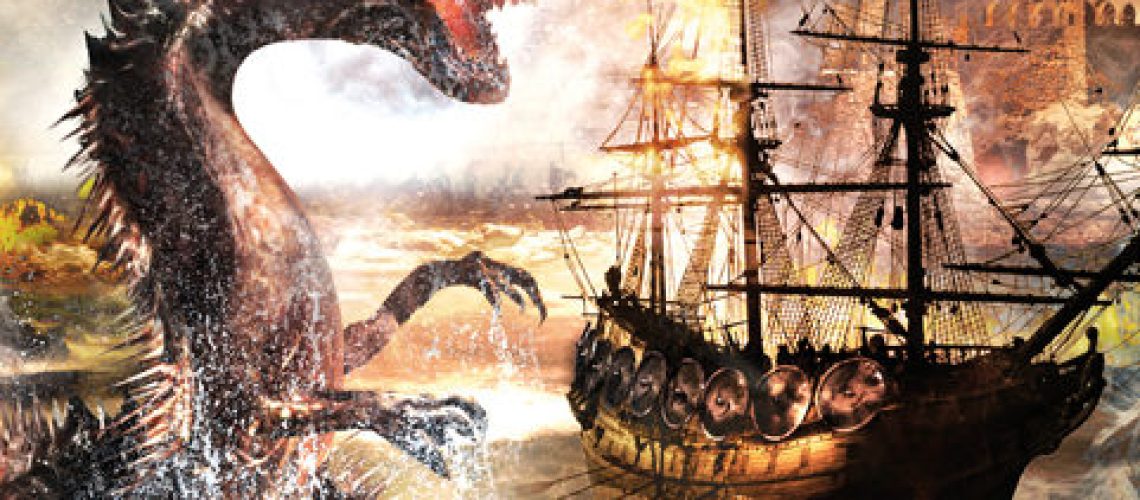Epic Fantasy sometimes takes just a dive into the deep waters to swim around to find oneself. Especially in a summary of a book’s plot. To wit: The Rubyholt Isles, to the south of the realms of the Sabian League and to the east of the burgeoning empire of Erin Elal, is a pirate-dominated tangle of dangerous seas and hard men and women. It’s also in the right position that any force from outside wishing to attach the Storm Isles of the Sabian League or land on the continent in the territory of Erin Elal must come to terms with the Isles, first. The pirates are too dangerous a potential adversary, and too valuable a resource, not to. And so when the head of an expeditionary force from the distant Augerans shows up in the Rubyholt Capital, the Storm Isles and the Empire alike take notice, and are forced to take action, before it is too late.
Red Tide is the third volume in Marc Turner’s The Chronicles of the Exile, following When the Heavens Fall and Dragon Hunters.

The first two novels in the series felt relatively independent of each other, as they took place in different portions of Turner’s world, and, roughly speaking, at the same time. When the Heavens Fall is a fantasy in classic overland Epic Fantasy mode, as the various characters and factions move across Turner’s well-realized landscape in search of a rather powerful MacGuffin. We get plenty of characters, plenty of scenery, plenty of action, adventure, and magic in what I call, after the Erikson novels, the Malazan school of epic fantasy. Malazan School of Epic Fantasy likes to throw ancient races, deep secrets, and meddlesome and quarrelsome gods and quasi-gods into the mix, often as viewpoint characters rather than mysteriously being offpage and offscreen.
The scope of the second novel, Dragon Hunters, was much more sword and sorcery style, focused on one city and one fortress. Still a relatively large cast of characters, but aside from the Spider Goddess, really no overlap of any note from the first book. Unlike the first novel, we also got a spectrum of characters from various social levels, from the mean streets of the city, law enforcement and criminal alike, all the way up to the ruling Storm Lord (Lady) herself. The novel was still heavy on the sorcery and magic, and was eminently readable as a new entry point for the series. Don’t want to read about a necromantic artifact? Fine. How about sea dragons and a plot to take political power? Here you go.
Red Tide is distinctly different. It is very much on the heels of the events of the first two novels, especially the second. Much of the setting of the novel is the still-devastated city of Olaire from the events in Dragon Hunters, along with the new scenes in the Rubyholt Isles. Unlike the change from the 1st and 2nd novels, this definitely bridges from both, merges threads from those novels, and then goes barreling forward. The inserts from the first novel are characters rather than settings, including my still-favorite character in the series, Romany Elivar. I was glad that the Priestess of the spider, long suffering and not at all happy at the latest commands from her Goddess, has returned from the first novel, and she remains as delightful as ever.
While it is definitely possible to read the first two novels in the series without having read the other (although the first novel does a lot more of the worldbuilding heavy lifting in setting up much of the world), Red Tide is definitely meant for readers who have read one, and ideally, both of the previous novels. While the author does a good job in memory-jogging about events in the first two novels, especially the second, the novel really isn’t a good entry point given the complexity of the politics and relations between the various actions, double-agents, factions, deities and more that fill the novel. If a reader isn’t at least jog-the-memory familiar with the machinations of the various players, then, like trying to read a Steven Erikson Malazan novel several novels in, the experience is bound to be frustrating.
So what does this novel offer for previous readers in the series? As usual, it’s difficult to speak terribly too specifically without spoiling the novel, or spoiling the previous two. There have been hints of the threat of the Augerans for the first two novels, and here those hints manifest in the Expeditionary Force. Their arrival upsets a lot of applecarts, and sends waves across Turner’s world in a believable and logical fashion. While the Augerans are not nigh-invulnerable, they are depicted as a definite threat and immensely dangerous. Seeing the Emperor, Avallon Delamar, backfooted as he is and having to deal with a existential thread to his Empire helps flesh him out and humanize him. Likewise, Mazana Creed, who rose to her station after the events of Dragon Hunters, comes in for some very nice character development as she, too, faces new challenges, even without the problem of the Augerans lurking down in the Rubyholt Isles. The more esoteric worldbuilding was intriguing, and expanded the world in interesting ways. There is even a really clever magical duel of sorts, a wonderful set-piece for me as a reader. The book offers much for readers of the series, and I now look forward to how the story continues.








0 Responses
I’ve only read Dragon Hunters by Marc Turner, but oh, man, was it good! I’m constantly telling people this is a series and author they need to check out.